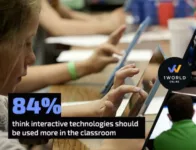1. Education Needs Change
Education is essential to helping the world progress, both technologically and socially. Unfortunately for many, access to education is not always readily available. There are many theories about how education can be improved but the ability to broadcast and disseminate knowledge is one of the easiest steps we can incorporate to enhance the standards of global education.
1World asked its members how they felt about their domestic education, and it was especially surprising to see the amount of dissatisfaction with education worldwide and a surprising amount people think their education system is lacking.
2.Education Needs More Technology
The amount of people not satisfied with domestic education clearly shows a need for change. The digital age has outpaced the traditional lecture and textbook paradigm and people expect much more than book learning, especially with the amount of information readily available on the internet and through mobile devices.
1World asked its members if they believed schools should incorporate more interactive technologies and 84% of respondents thought it was a necessary step. However, adding more technology to the classroom isn’t as easy as giving all the students iPads—it’s important to implement the right types of technology as well. Video capture technology is one of the most essential tools a modern classroom can incorporate, especially with the increasing popularity of e-learning.
3. Greater Access to Education
Access to education is one of the biggest hurdles facing the world right now. Even in developed countries, many people are struggling to earn degrees and pay for their college education. Access to college education is more important than ever before, even more so since 48% of people claim a Master’s degree is required to get a good job these days.
Distance learning programs and open courses have the ability to transcend the limitations of a physical classroom presence. When run properly an electronic course can greatly exceed the results of a traditional classroom setting not just in scale, but in interest and interactivity as well. Potential students are much more likely to choose courses which are useful to them, which helps ensure the students will get the most out of their educational experience.
4. The E-Learning Revolution
E-Learning has been gaining a lot of traction in the past few years, and the negative connotation of distance learning has started to wane. In a recent survey, 62% of respondents reported that e-learning will be an important next step for the evolution in education, and with major power players like MIT and UC Berkeley offering online course offerings for free, as well as online education providers like Coursera, now is the time for other institutions to start implementing their own online courses.
The great thing about broadcasting course materials is that there is little, if any, need to change the lesson plans and lectures that have already been created. As long as the educator has a tool to capture and upload their class sessions, they can use any of the Content Delivery Network (CDN) or Content Management Systems (CMS) like Blackboard, Livestream, or Moodle to administer an online course.
Most educational institutions already use on a CDN or CMS to upload recorded sessions, but very few institutions have implemented video capture technology across the platforms. One of the biggest hurdles to widespread implementation is that most of the systems for recording and broadcasting require installation of dedicated hardware which can be hard to move from class to class, and let’s face it—using a laptop webcam to broadcast a class is probably the worst way to implement class offerings on a wide scale.
However, there is a portable option available on the market called Epiphan Pearl, which is capable of capturing two HD sources simultaneously. The dual capture input is especially useful for professors who incorporate multimedia in their classes and need to switch between lectures and visual outputs like PowerPoint presentations or online content.
5. How Can Educational Institutions Enact Change?
Depending on the size of the institution and the scale of the scheduled changes, it wouldn’t take much to create a global ecosystem of top-notch courses available around the world. Even one or two video capture units per school could help create a robust educational ecosystem worldwide. It isn’t too late to join the revolution, but there are already some great programs available around the world, like Australia’s Open Universities, a consortium of 13 schools with a mix of undergraduate and post-graduate courses.
Technological pioneers in education just need to start the process of recording and broadcasting their classes in order to achieve a wide variety of positive results. The institution and instructor gain a wider audience and increase their reputations as thought leaders. Potential students will have remote access to quality education, and whether the students are domestic or abroad, the net result is beneficial for communities worldwide.
In other instances, educators can leverage their expertise to enact social change by teaching specialized information directly to affected communities, such as teaching architecture to developing nations to increase the integrity of buildings to withstand disasters. In other cases, communities and school districts with underperforming schools can learn how to better administrate classrooms using practices from successful schools.
What’s Next?
E-learning has a definite possibility to change education as we know it, and it certainly won’t be going away any time soon.
If you want to hear more about the topic, stay tuned for our upcoming debate on education where our experts will argue whether online degrees should be granted the same weight as those from traditional institutions.








